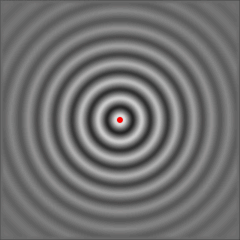This article needs additional citations for verification. (February 2013) |

An isotropic radiator is a theoretical point source of waves which radiates the same intensity of radiation in all directions.[1][2][3][4] It may be based on sound waves or electromagnetic waves, in which case it is also known as an isotropic antenna. It has no preferred direction of radiation, i.e., it radiates uniformly in all directions over a sphere centred on the source.
Isotropic radiators are used as reference radiators with which other sources are compared, for example in determining the gain of antennas. A coherent isotropic radiator of electromagnetic waves is theoretically impossible, but incoherent radiators can be built. An isotropic sound radiator is possible because sound is a longitudinal wave.
The term isotropic radiation means a radiation field which has the same intensity in all directions at each point; thus an isotropic radiator does not produce isotropic radiation.[5][6]
- ^ Graf, Rudolph F. (1999). Modern Dictionary of Electronics. Newnes. p. 398. ISBN 9780750698665.
- ^ "Isotropic radiator". Electronic engineering glossary. In Compliance magazine website. 2009. Retrieved 28 February 2024.
- ^ Richards, John A. (2008). Radio Wave Propagation: An introduction for the nonspecialist. Springer-Verlag. pp. 1–2. ISBN 9783540771241.
- ^ Weik, Martin H. (1989). Communications Standard Dictionary, 2nd Ed. Van Nostrand Reinhold. p. 555. ISBN 9781461566748.
- ^ Cite error: The named reference
Howellwas invoked but never defined (see the help page). - ^ Cite error: The named reference
Demtroderwas invoked but never defined (see the help page).

